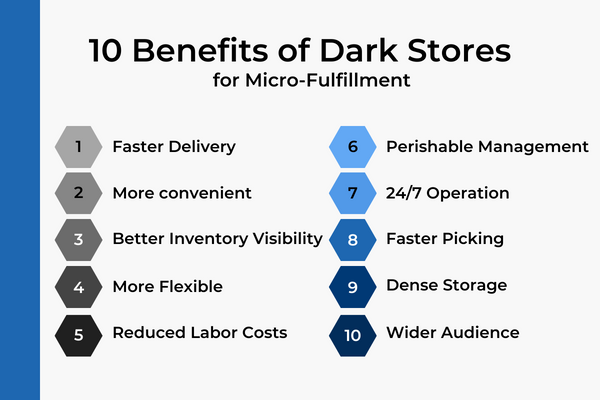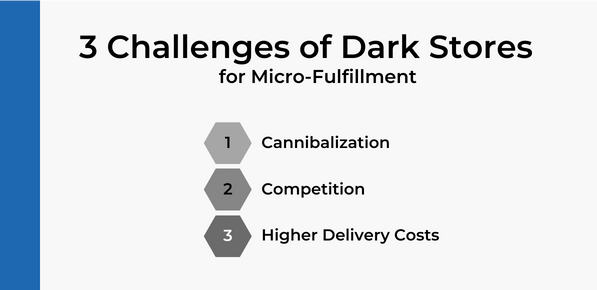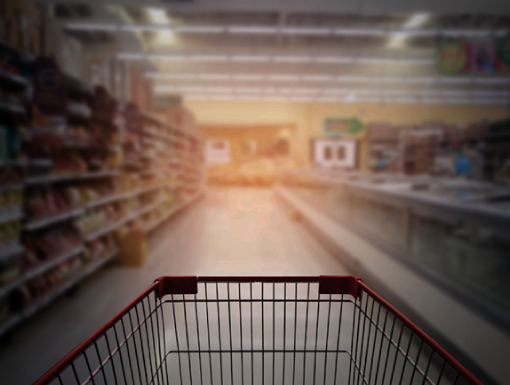What is a Dark Store?
Online shopping has been and will continue to gain popularity which is encouraging retailers to be more strategic in their fulfillment methods. Micro-fulfillment is a strategy of placing smaller distribution centers closer to population centers in order to meet the needs of same-day or next-day delivery. When people discuss micro-fulfillment and micro-fulfillment center automation, the term “dark store” may arise. So, what is a dark store?
A dark store is a type of retail micro-fulfillment center that is repurposed from a retail location that is no longer profitable as a storefront. The term “dark” refers to the fact that these stores are not intended for customers to enter and browse. Rather, they are used solely for the purpose of fulfilling online orders. In other words, a dark store is basically an e-Commerce order fulfillment center that uses the existing infrastructure of brick-and-mortar locations.
Dark stores are designed to be more efficient than traditional warehouses, with specific layouts and processes that allow for faster order picking and packing. Dark stores usually have a smaller footprint than traditional warehouses, and are often located in urban areas to be closer to customers.
How does order fulfillment work in a dark store?
Dark stores can offer a few different types of order fulfillment, each with varying convenience to the customer and associated costs to retailers.
The two types of order fulfillment from a dark store is called “ship-from-store” or “click-and-collect.”
Click-and-collect (curbside pickup): Customers can place orders online and choose to pick them up at the physical stores. The customer will park in a designated curbside-pickup parking space, and an employee will bring the order out to the customer’s car.
This type of order fulfillment is becoming more popular amongst retailers as it offers customers the convenience of shopping online with the added benefit of being able to pick up their orders at their convenience rather than waiting on the delivery.
Ship-from-store: Customers can place orders online and choose to have them delivered locally. This is the most convenient option for the customer, however, it significantly increases costs for retailers.

10 Benefits of the Dark Store Fulfillment Centers
The dark store fulfillment model has several benefits for retail eCommerce businesses.
1. Reduced Delivery Times. Dark stores can help to reduce delivery times, since orders can be fulfilled more quickly than from a traditional warehouse, and they are typically located relatively close to the end consumer.
2. Convenient for Customers. Dark stores enhance the customer experience of shopping online , since they are more likely to be located near population centers.
In addition, the Pandemic has forever changed the trajectory of online shopping, the use of dark store fulfillment allows customer to shop contact-free.
3. Greater Visibility & Inventory Tracking. This store concept can help to improve supply chain visibility, since orders can be tracked more closely from the time they are placed until they are delivered. Greater inventory management, visibility, and accuracy means fewer out-of-stock situations and substitutions. Once you implement a dark store, calculating inventory accuracy is essential to establishing your baseline data.
4. Increased Flexibility. This model is also more flexible than traditional warehouse fulfillment, since dark stores are smaller and can be quickly adapted to changes in customer demand.
5. Lower Costs. The dark store model can help to reduce overhead costs, since dark stores are typically smaller and require fewer store employees than traditional warehouses.
These stores are often located near populated areas but are usually in more industrialized areas, which means lower (typically) lower rent costs than the average retail store.
6. Easier Perishable Management. The dark store concept can also help to improve perishable inventory management, since orders can be fulfilled more quickly and closer to the customer.
7. 24/7 Store Operation. Dark stores can operate around the clock which helps to further improve efficiency and customer satisfaction.
8. Optimized Layout for Fast Picking. In retail stores that are open to the public, the layout is typically designed to keep the customer in the store longer. For example, grocery stores put eggs and milk in the back of the store, so you have to walk through multiple aisles and products to retrieve them. In a dark store, the optimal locations for products are not based around the customer. Instead, more popular items are sometimes placed closest to the door, decreasing the picking, packing, and shipping time.
9. Dense Storage. Since dark stores are closed to the public, the layout can consist of narrower aisles and taller shelving for stock. Hence, more items can be stored in a smaller footprint.
10. Larger Product Selection & Audience. A wider variety of SKUs can be carried in dark stores because of the dense storage capabilities. Therefore, you can appeal to a broader audience.

The challenges of dark stores
Cannibalization. In-store retail sales could be cannibalized. If your customer-base switches to online ordering, self-service retail stores will have less revenue while maintaining the same operating costs. Therefore, profit of self-service stores would go down. This is why strategic site selection is important, and working with a supply chain consultant is crucial.
Competition. Customers are more likely to switch between online retailers to find the best deals because it’s easy and each retailer offers essentially the same convenience. It would take me 10 minutes to leave a grocery store and go to a different store in search of a specific product, but it only takes about 3 seconds to open a different tab in my browser and search another website. Therefore, the competition is higher online.
Cost. Transportation costs may end up being be higher depending on the location in relation to the customers. Home delivery routes can be long, and the need to fulfill click-and-collect orders at the store means that additional handling costs are incurred. These higher costs offset a significant portion of the reduction in picking costs achieved by moving picking out of the stores.

How to ensure your dark store is profitable?
1. Make sure there is enough demand.
If you don’t have enough demand for online orders or the right order profiles to yield enough profit, it might not be worth your time or money to set up a dark store. You need to make sure that you will generate enough business to cover the costs of operating the dark store.
2. Find the right location.
The key to a successful dark store is finding the right location. The store needs to be close enough to your customers so that home delivery is quick, but it also needs to be in an industrialized area so that you can keep costs low.
3. Choose the right technology.
You need to have a robust order management system (OMS) in place so that you can keep track of orders and stock.
If you offer delivery options, you need to have a good shipping solution so that you can get orders to your customers quickly and efficiently.
4. Implement an efficient picking strategy.
The layout of the dark store is absolutely crucial in keeping store operations efficient. Fast-moving SKUs should be placed near the packing / shipping area so that it takes less time for the product to move through the store and be ready for pickup. For example, in grocery stores, milk, eggs, and bread should be nearest the outbound door.
The use of batch picking (or fulfilling multiple orders at once) as you move through the aisles and shelving is an optimal pick strategy to reduce pick time.
Conclusion on “What is a Dark Store?” and “Is it Right for Me?”
If a retail location is no longer making a profit, it can be turned into what is called a dark store. These stores get their name from the fact that they are not open to the public– rather, they only exist to fill online orders. In other words, dark stores are e-Commerce order fulfillment centers that use old brick-and-mortar locations.
You should think about your customer’s demands and the distribution network in order to decide if dark stores are appropriate for you business. If you have a large number of clients who live in cities and require quick delivery, a dark store may be an excellent solution. A different fulfillment method, however, may be more suitable if you have a smaller client base or customers are distributed across a greater geographical region.
If your grocery, food, or retail business is considering dark stores as a way to offer better service and convenience around online orders and shopping, it’s very important to work with a supply chain consultant. A consultant can help you achieve healthy profit margins and ensure that retail store sales are not cannibalized.






